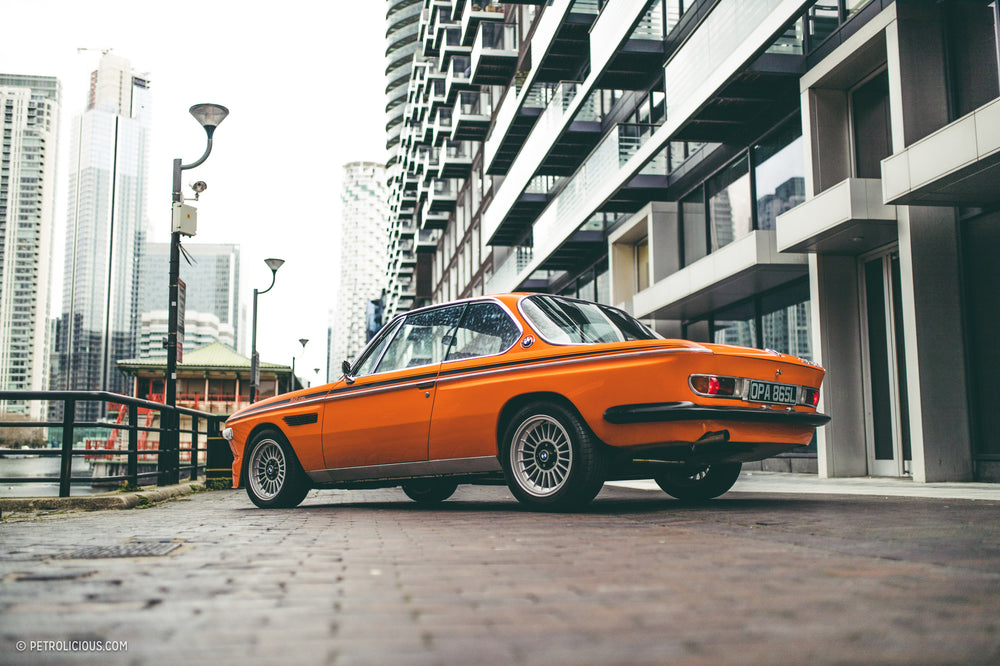Feeding on the corpses of the old warehouses, the skyscrapers of the London Docklands rise ever higher, with cranes playing the role of the remora, high in the air. It’s a quiet Saturday morning, the streets are deserted. Even so, energy fills the air. It’s hard not to feel something in the atmosphere of this city, especially here at the Docklands, where life moves fast and with massive impact.
The reason we are here is to enact a reunion of sorts, to resurrect a dialogue between two very different groups of people. Together these groups created a colossal cultural icon, and they shaped society in ways they probably would not have envisaged at the beginning of this intertwined journey. They were engineers and bankers.





The engineers were German. From Bavaria. Stubborn. Determined. Modest. Talented. Focused on doing what they know they did best. But the powers that were tried to stop them from doing their jobs, with both the Nazis and the Allies forbidding BMW to produce automobiles. In a very short span of time, BMW went from feeding the Nazi war machine to making cookware in the direct aftermath. By the early 1950s, the company found some footing.
The engineers wanted to do only one thing, and now they could. They wanted to produce cars that were livable but with dynamic performance under the skin. Cars that last, are as user friendly as possible, are comfortable at low speeds, and most of all, and easy to live with. They knew how to build such things, and by the 1960s, with its "Neue Klasse" automobiles, they were on track to becoming a luxury option to be reckoned with. But the luxury market is among the most conservative out there—how was BMW going to woo doctors and lawyers out of their Mercedes-Benzes and into a Bimmer?




Enter the bankers. From the biggest financial centers of the world. A new breed of financiers. Ever moving, ever aggressive, living intense lives that resembled nothing else in the past. The past was just another thing they had no time for. They would become part of the core UK customer base for BMW's higher-end offerings, but in the late 1960s, this relationship was still a very unlikely one.
The place that is now a symbol of immense wealth and financial action was in ruins, a dangerous urban jungle that sane person rarely sought out. A hole in the heart of London. The Docklands all but completely collapsed during this decade. Despite surviving the Blitz and also having enjoyed a short-lived renaissance thereafter, the move to modern container ships seemed to seal the fate of the Docklands as a place on its way towards uninhabitability. By the early 1970s however, something new took hold.






This was going to be the age of the shark. Out of the water surrounding the Docklands, the financiers and property developers started building the skyscrapers that would become their empire. For better or for worse, they were the London sharks, apex predators of the financial world. And what better symbol to reflect upon the world their impressive status than something like the BMW E9 CSL, the ultimate shark. The car brought the Bavarian marque so much success in touring car racing in the 1970s, while the street version's impact is still felt today. It was impossible not to take notice of what the early Neue Klasse coupes had evolved into.






It’s easy to be overwhelmed by the CSL. The racing cars were covered with wings and ducts, and the street cars sporting similar kits from the factory were aptly dubbed Batmobiles. This Inka Orange UK-spec CSL is not a "Bat," but it has its share of flair, and flare. It makes no attempt to hide its presence (how could it?), with the orange hue making the car all but glow among the dreary greyscale of London on a foggy day.
And the sound of its straight-six is unmistakably BMW, a subtle sound, but it's a noise with body, with potential. The interior still has wood on the dash, but the CSL-specific Scheel bucket seats are straight '70s race car. Thanks to the Zender "Group 2" flares and wider, larger Alpina wheels, the Batmobile's front aero, and the ultralightweight CSL rear bumper, the car's stance is aggressive, yet nothing you would call outrageous (though I'm sure some CSL purists out there will disagree). Restored and modified with period-correct parts in the 1990s, it is a unique example of the CSL platform.



The CSL as a model is a car that perfectly represents the real renaissance of BMW. Most of the design is shared with the Neue Klasse Coupes, giving it a direct connection to the series that saved BMW from certain bankruptcy, the series that was designed when the the company was going through its darkest postwar period. But it was a car that looked to the future, and established it, cementing BMW as a preeminent force in motorsport. Thanks to the work of Bob Lutz and Jochen Neerpasch establishing BMW Motorsport (today BMW M), the brand would spend the next decades leaning into its sporting identity, and the CSL was the first creation to emerge from that storied division. And in 2020, it's just as mean a predator as ever.
































































